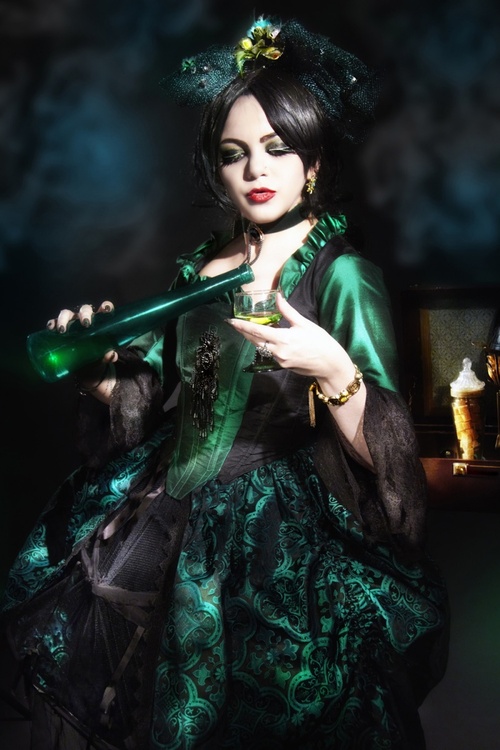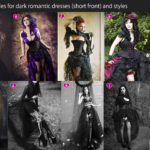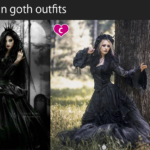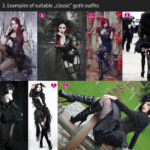Introduction to gimbo girls – The different sub-styles for gimbos
“Tenue tragique noire absolument obligatoire” – Karl Lagerfeld
(“Black tragic dress absolutely required” – Karl Lagerfeld)
Welcome to our first real post in our new series about the different substyles in the gothic community, after our brief introduction. Fear not: Like I told you, this is still a blog dealing with bimbofication – no gothic lifestyle blog, so you won’t sit through a whole article packed with boring statements, summaries and analyses about those substyles (for that, go here!), instead we’re going to pay attention to the gimbo related parts only, after just a very brief and small introduction to our first substyle, which is often called “dark romantic“, “Victorian gothic” or even “classic romantic”. I like to stress this again: In this series, we are NOT going to talk about the essential properties of the cultures, argue about general definitions and such, but we will only focus on broad categories, which is why I will condense multiple substyles into one, and center on gimbo suitable aspects like wardrobe and style in said broad categories. Think of this like of most of the articles I’ve written about different pieces and styles in the “bimbo style category” (tube socks, nightwear, stripper heels, etc.). Because I do know, that in many of these substyles, very different dresscodes are in effect, I felt the need to give each of these sub-subcultures an individual, fitting, gimbo-suitable modified version of its dresscode – for all those aspiring gothic bimbos and gimbo trainees out there, that do not know how to advance and match their style with the requirements of dressing like a true gimbo doll or gothic barbie. So, let’s begin:
1. Classic / Dark Romantic / Vampire / Dark Wave / Victorian
A brief introduction and explanation
The first genre we are talking about today was chosen not without a reason. It is very likely, that this is the style everyone who isn’t that deep in the gothic culture, thinks about first and imagines when the term “gothic” is dropped. I have condensed some slightly different archetypes into one, because they all share very distinct and similar aspects regarding the anticipated dresscode for participating girls, regardless of differences in music and cultural background. Of course, not every girl in this niche has read Anne Rice and her “Vampire Chronicles“, or legends like Edgar Allan Poe, E.T.A. Hoffmann, Lord Edward Dunsany, Mary Shelley or Lord Byron (though you should… yes, all of you. It pays!), but it is undeniable, that most of the charm, style and aesthetics, adapted by these girls, base on the writings of these gods and goddesses of early fantastic literature. But not only books did lay the foundation of the visual style of this movements. Gothic horror movies like “The Fall of the House of Usher ” (directed by Roger Corman and with Vincent Price, who both became themselves icons of the dark romantic gothic genre), “Witchfinder General” (again with Vincent Price) or “The Pit and the Pendulum” (again, Roger Corman and Vincent Price) and later on movies from Tim Burton like “Edward Scissorhands” did form and shape the visual aesthetics of this archetype, as well as the architecture and art of many of the settings and timeperiods those stories are established in. (Going full circle here with Tim Burton, Vincent Price and Edgar Allan Poe coming together…). You know what this means for the anticipated dresscode for the ladies: Magnificent, victorian ball dresses, with overskirts, crinolines and adornments. Elegant hairstyles, very tight corsets, pomp, splendor and luxuriance as far as the eye can reach – in black. Did you think of “Interview with the Vampire“? Yes, exactly – mixed with Tim Burton and some “Belle Époque”. Everything here can be cooked down to something we call “Das Erhabene” in German, which would mean “sublime” in English, something so marvellous and grandiose that it reaches an appeal beyond just elaborate, ascending to become nearly unearthly or holy in its aesthetics. The queens of the dark scene. Already, we are able to make some assessments regarding the anticipated requirements and needs of this substyle, as well as the aspects gimbos should be focussing on to fulfil the demands of gothic bimbo appeals and to surpass all the other girls in the club. Being a gimbo is not about being just fantastic or beautiful or sexy… it’s about being sublime!
“Das Erhabene” – Or the aspects of Victorian/Edwardian Gothic styles that are interesting for gimbos and what goth bimbos should focus on
Now, as we have stated that it is not about being just average, I have to confess, that I kept back with certain fact here: The magnificent dark victorian style is certainly not the average visual style MOST normal goth girls make use of. Too much effort is needed for the normal girl in the gothic community to maintain this style, just for a normal evening in the club. This is one of the reasons, why normal, casual goth girls go for the toned down „classic“ style, which is often far less elaborate, costly and extravagant – and most likely one of the common sights in the clubs or when you see goth girls on the streets. This is not a severe problem, because the general goals and effects of this style are the same as of the more flamboyant versions and they share many pieces of clothing and the same design philosophy. However, true gimbo girls are compelled to always perform in the best way possible and to never let their styling slide! So let us have a look at those effects:
1. Aspects and details of the Victorian/Edwardian era
Victorian fashion for women was NOT utilitarian, and it was never intended to be. This is everything you need to know. In this epoch, gender roles were more defined than ever, and women and girls we not expected to work nor to pursue any kind of activity that involves any form of physical labor or stress. This was reflected in the way women tended to dress, not in a way that would make it much easier to be involved in agitations which would require the possibility to make use of mobility or liberties of action, but quite the opposite, in a way that restricted free movement but was beautiful to look at. As you see, the way women dressed, was solely about „showing off“, their social status, lifestyle and feminine beauty. In a way, the Victorian era may be the very first example of broadly socially practiced and accepted bimbofication, with women solely dressing and styling to reflect their status and their femininity, by sacrificing ease, comfort and easiness. This sacrifice results from the fact, that nearly all of the involved pieces of clothing were either uncomfortable to wear or restrictive in terms of movement. Even today there are still many aspects of this principle reserved, like the certain appeal of high heels despite their unquestionable discomfort and the limitation of fast and easy locomotion. From this we can derive one of the main rules, not only regarding this special style, but the way of styling gimbos and bimbos have to chose generally: Appeal over utilitarianism! ALL THE TIME! This is somewhat already discussed in our basic rule about „always dressing to impress“. Some examples of garments of that epoch with restrictive or inconvenient characteristics, but beautiful to look at, are, most famous, the corset (ever-present in the gothic community!), petticoats, overskirts, crinolines (could be VERY heavy), pagoda sleeves, bustles, tournures and bustiers – all of them often seen in this sub-genre of the gothic culture.
2. Appeal of femininity, especially the grace and elegance of female nobility and aristocracy
Of course, you might say, even in the Victorian era, there were many women who did have to work and who couldn’t afford those expensive garments, and yes, your would be totally right. The most costly and lavish pieces were reserved for the nobility and upper class women, but even middle class women exhibited similar dress styles; however, the decorations were not as extravagant. This is the time to bring to mind the poetic and popcultural background of the gothic culture: It was never about a real representation of social classes from those times, but a selective pick of specified characters and tropes. Think about the noble and wealthy quarters of female vampires in literature, going to the opera in costly garments, symbolizing the decadence of the Victorian era, the lonely and tragic princesses suffering in dark castles and manors of the gothic horror universe – beautiful and magnificent – but always tragic and perishing, the betrayed and murdered bride of a wealthy family (or the one trapped in Phantom Manor…evermore), the demise of the bourgeoisie, falling in bitterness but pride and classiness before the feet of the rising proletariat. This is what the beauty of that literature and the ficition is all about, and this is what the girls think of in combination with the normal fantasies of being a princess when they were small. Let us be totally honest here: No one cares for the lower class women who grafted on the fields the whole day in rags and plain clothes. This is perfectly normal and absolutely fine and even bimbo/gimbo fitting! The Victorian/classig gothic bimbo is a princess, a duchess, a baroness or even a queen amongst her fellow campaigners. She has to be outstanding and overly gorgeous, splendid and glorious! All the other girls around her have to be degraded to hick girls by mere visual comparison. So, the second rule we can derive from this is: Strive for the pomp, splendor, grace, elegance and glory of the nobility and the aristocracy of olden times. Exaggerating explicitly allowed and requested! And remember: This is NOT a reenactment of historically authentic representations! Styles, textile fabrics, items, clothes and cuts which weren’t used in those times are absolutely permitted! It is about the general appeal, the emanation and the impact you achieve by aiming at these borrowings!
3. Classy sex appeal
Apart from low shoulder neck-lines, the Victorian era didn’t deliver much in terms of sex appeal when it comes to showcasing naked skin. BUT this is not a problem, because of two reasons: 1. The special sex appeal of these styles is not necessarily determined by showing much naked skin. It is mainly generated by the extremely feminine appeal, the elegant and classy style and the supercilious and aristocratic emission. This can further be enhanced by the correct behaviour and charisma: Don’t have a beer, take a nip of your red wine or absinth in the club. Don’t dance like a maniac, either perform in a slow, elegant, sexy and majestic movement, or do something like the circle dance. Look down on the other girls and maintain your aura of superiority and supremacy. 2. As we already established, it is not about historic accuracy! You may very well (and should!) use sexy parts, items and wardrobe from neighbouring substyles and other time periods! Choose a black balldress with a crinoline that is so short at the front, that the lace of your stockings is clearly visible, or that is so short at the back, it exposes your ass. Combine that with many other pieces of the gothic dresscodes, like garter belts (3B), elegant stockings (1E), underbust corsets (1C), high heeled, black boots made of patent leather (3C, 3G), stripper heels or bondagetops (1H). You can very much rely on the special sex appeal of the aristocratic appeal of your style – but a true gimbo does show off some skin, especially her tits, her legs and her ass, at least from time to time.
This style modified and adjusted for real gimbos – Never dress in a utilitarian way!
Okay, we talked about the general appeal of the style of this subgenre. But what distinguishes a normal victorian/classic/romantic goth girl from a gimbo with the same obsession (apart from the sooner or later inevitable aspects like giant, enhanced, tits, a perfect, pristine and shaped body, flawless make up and so on)? If you are a goth girl practicing this general style, what do you have to change to please the needs of gimbofication in terms of dressing? Let us remind ourselves of the three lessons we learned here: 1. Appeal over utilitarianism! 2. Go for an elegant and noble style – Exaggerating explicitly allowed and requested! 3. Be classy AND sexy! What does this mean in terms of clothing? Well, gimbo girls do have to follow most of the same rules as bimbo girls, so let us clarify some basic laws here first: Always wear high heels. Always dress to impress. Never mix underwear. Wear your tops one size smaller. Never wear pantyhoses (ALWAYS choose stockings!). Never wear pants. Set the standard. Wear your stockings correctly. In combination with what we have learend so far about this special sub genre, lets us collect some ideas. Imagine the vampire baroness of your dreams. The dark princess of the black castle. And combine that with aspects of bimbofication. In order to achieve a rich and magnificent look, wear great amounts of jewelry (massive necklaces, rich and spectacular earrings, dissolute diadems, many rings, jewelry to draw attention to your neckline and tits, etc.), (1.A, 1F, 1J) , excessive hair ornaments in elaborate and fancy hairstyles (suitable for queens and princesses), (1A, 1D, 1F, 1B), and really heavy make up. A corset is mandatory, tightly laced to achieve a true wasp waist and to push your tits up. Wear a very low neckline to draw attention to your tits (1B, 1C, 1F). You may choose elaborate, rich and breathtaking ball dresses, with petticoats, underskirts or crinolines, but remember to maybe leave either the front- or back-side „shockingly“ short (like described above, all from “1”). Always wear stockings or stay ups (NEVER damaged or torn!), (1C, 1E, 1F, 1I, 1J), with broad and rich lace collars. This will give your style the needed addition of slutty sexappeal and elegance. This whole styling genre is VERY suitable for gimbo girls, because it allows them to underline their status and position of superiority and nobility compared to other, normal goth girls. The primary color to choose is, of course, black. You may combine this with at least one other color – but it should be a toned down, dark shade – not bright or popping, (1B, 1D, 1E). In this case, it is not about the naive girly mentality, but about the plush and gallant facets of yours. Always wear high heels. Either some shiny, black, high heeled boots (like the standard boots for goth girls), (1G), or some black stripper heels or high heeled pumps (1E, 1I). Your overall outfit, the dress, the skirt, the corset, the overskirt may be crested and adorned with ornaments, (black-)flowers, lace or jewelry – Go crazy! The more pomp and pageantry – the better (2.A, 2B, 2C, 2D)! Enhance the appeal with accessories like a fan made of black lace or a tricorn. If you want to go for the toned down, more „classic gothic“ style, you should still try to maintain the basic aspects we have talked about. Of course you may choose a fairly bare, black dress, but then you must assure to tune up every other aspect of your style (3A, 3B, 3C, 3D, 3E, 3F, 3G)! Said black dress might be unspectacular on the first glance, but maybe it has a very high side cut, or is VERY short (3A, 3D) , which reveals your garter belt and gives you an opportunity to show off your legs and the sky high heels or stiletto overknee boots you are wearing? In combination with a matching corset and heavy make up this may very well work out. NEVER be lazy or modest! You are a queen amongst other, normal, boring goth girls! Be a gimbo and remember the women of the Victorian era you are borrowing from: Style over convenience, femininity over practicability, sex appeal over modesty! Pay attention to the rules, always respect them and make sure you are emanating the appropriate style, nobility, grace and elegance that can be expected from a Classic/Dark Romantic/Vampire/Dark Wave/Victorian gimbo princess! As a gimbo, you are always classy and princess-like – NEVER look “fucked-up”, punk-like, casual, messy or wasted!
Discuss this on the academy subreddit!
Support me on Patreon! Every donations helps me to write more and better posts! Thank you very much!
Support me by donating in different crypto currencies, or visit my shop!





